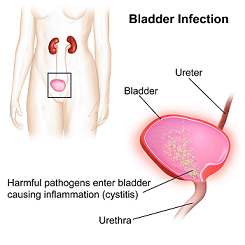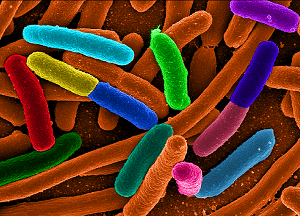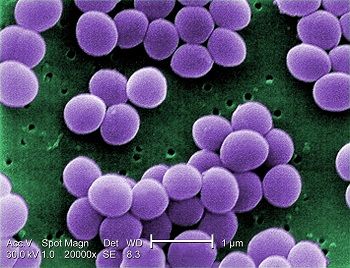Asymptomatic bacteriuria

Asymptomatic bacteriuria (AB) also known as Asymptomatic Urinary Tract Infection (UTI), is a phenomenon that describes the presence of significant bacteria (≥ 105 cfu/ml) in an individual’s urine without the manifestation of signs and symptoms. The presence of bacteria in urine should not be ignored, because people with asymptomatic bacteriuria are not aware that they are infected and hence the possibility that they might not be tested nor treated. It is also more likely that an individual with asymptomatic bacteriuria develops subsequent symptomatic UTI than people who do not have asymptomatic bacteriuria, therefore it could be regarded as an indication of possible urinary tract infection in the future.
Urine, a transparent solution that appears colorless, amber and sometimes pale yellow, is often believed to be sterile and free of pathogens until it reaches the urethra. Urinary tract infection (UTI) is a clinical or subclinical infection caused by pathogens that invades either the lower urinary tract, upper urinary tract or the entire tract.
The manifestations of signs and symptoms of urinary tract infection depends on the part of the urinary tract involved, the severity of the infection, the etiologic agent(s) or the pathogen involved, and the individual’s immunity. Signs and symptoms of UTI may include fever, chills, urinary urgency, dysuria, and cloudy or foil-smelling urine. Prolonged UTI may results in diseases such as urethritis, prostrate-prostitis, cystitis and pyelonephritis etc.Predisposing Factors
Age: The prevalence of bacteriuria in healthy women increases with age, from about 1 percent in females, five to 14 years of age to more than 20 percent in women at least 80 years of age living in the community
Sex: women accounts for the higher number of UTIs than men. Premenopausal, nonpregnant women with asymptomatic bacteriuria usually have no signs or symptoms and the infection is self limiting (will clear spontaneously), However, the probability that women who are positive for asymptomatic bacteriuria might experience subsequent symptomatic UTI is more than in women who do not have asymptomatic bacteriuria
Sexual Activity: Sexual activity may increase the risk of bacteria invasion into the bladder area.Women with asymptomatic bacteriuria during pregnancy are more likely to deliver premature or low-birth-weight infants and are at higher risk of developing pyelonephritis during pregnancy compared with women without bacteriuria.
The Presence of Genito-urinary Abnormalities: Genito-urinary abnormalies has been identified to increase the incidence of bacteriuria .
Presence of Underlining Disease : In Patients with long term diseases such as diabetes mellitus and chronic renal or liver failure and malignancy, there is higher tendency of contracting Urinary tract infection unlike people who are presumed to be healthy.
Aetiological Species for Bacteriuria.
Escherichia coli is the most common organism isolated from patients with asymptomatic bacteriuria The ability of uropathogenic E. coli to cause UTI is as a result of the ability to express a variety of virulence factors, including adhesions, fimbriae (Pilli) and toxins (e.g., hemolysin). The presence of the pili as virulence factor enables this pathogen to travel to the urethra and infect the bladder. Upon further upward movement of E. coli, it also infects the kidney. Adherence to the urinary tract epithelium enables bacteria to resist removal by urine flow.
Proteus mirabilis is capable of causing symptomatic infections of the urinary tract including cystitis and pyelonephritis and is present in cases of asymptomatic bacteriuria, particularly in the elderly and patients with type 2 diabetes. These infections can also cause bacteremia and progress to potentially life-threatening urosepsis. Additionally, P. mirabilis infections can cause the formation of urinary stones (urolithiasis).
Klebsiella sp is an enteric encapsulated [O antigen], but non motile organism. It causes urinary tract infection in hospitalized patients especially those with catheters. Klebsiella sp accounts for about 15% of all nosocomial urinary tract infections (UTI) and shows a higher incidence in specific groups of patients at risk e.g. patients with neuropathic bladders or with diabetes mellitus.
Pseudomonas aeruginosa is an obligate aerobic, non lactose fermenting gram negative rod.its has a weak invading ability, however it is generally believed to be the third most common pathogen associated with nocosomial catheter-associated UTIs . It is capable of colonizing immunocomprised individuals and has a tendency to form biofilms(that contribute to its pathogenicity) on the surface of urinary catheters. P. aeruginosa is resistant to almost every antibiotic and it also possess a capsule that is antiphagocytic and aids adhension to target cells.
- Group B Streptococcus is a leading cause of meningitis in neonates.Group B Streptococcus can infect pregnant women causing sepsis and bacteremia. The colonization of the cervix and vaginal by the Group B Streptococcus in pregnant women can result in vertical transmission of Group B Streptococcus to neonates. There is also an increased incidence of Group B streptococcal infections in non pregnant adults resulting in sepsis, pneumonia and in some cases cystitis especially in people with underlining diseases such as diabetes mellitus and chronic renal or liver failure, malignancy etc
How can we prevent Urinary tract infection?
Urinary tract infections can be very annoying because they can the individual uncomfortable, thus the following measures can taken to prevent Urinary tract infections .
- Clean up by wiping front to back after urinating or defecating, to prevent bacteria from entering the urethra.
- Avoid products such as douches, feminine sprays and the use of spermicidal jelly which can suppress the virginal normal flora.
Why Border about Asymptomatic bacteriuria?
Is the treatment of asymptomatic bacteriuria is necessary and important? Since young women especially the non pregnant ones with asymptomatic bacteriuria do no experience adverse effects and with the potential to clear their bacteriuria spontaneously, although women with asymptomatic bacteriuria are very likely to have subsequent symptomatic UTIs than women who do not have asymptomatic bacteriuria .
To answer the question, please note that:
- Treatment of asymptomatic bacteriuria is not recommended for healthy, premenopausal, non-pregnant women because there isn't any known risk for this group of people. For emphasis, please it is important not to treat patients with asymptomatic bacteriuria unless there is evidence of potential benefit because of the issue of increasing antimicrobial resistance. There is a few cases where the treatment of asymptomatic bacteriuria has produced positive outcomes?.
- The suppression or eradication of bacteriuria by antibiotic courses is difficult, time consuming, costly, and potentially hazardous, screening for and treatment of AB patients should arise if the bacteriuria has a related adverse effect (such as progression to chronic kidney disease, bacteremia, development of a symptomatic urinary tract infection etc.) that can be prevented by antimicrobial therapy. For example in pregnant women who are likely to develop pyelonephritis and as well as delivering a low birth weight infant or premature delivery should be screened for asymptomatic bacteriuria in the first trimester and treated, if positive, another scenario is prior to urologic procedure, where there is a risk of mucosal bleeding, patients should be screened for bacteriuria, because of the risk of post-procedure bacteremia and sepsis.
Can Asymptomatic be prevented?
Yes, it is generally believed taking of cranberry could be used to prevent UTI through the principle of acidificationThe primary role of cranberry for the prevention of UTI is urine acidification. It has been discovered that cranberry proanthocyanidins possess a special antiadhesion active constituent. Escherichia coli with flagellums can produce adhesive molecules that can be attached to the epithelial cells of the urinary tract. And because cranberry has such bacteria-proof antiadhesion mechanisms, it can prevent UTI caused by common pathogens
However, according to the research carried out by Shu-ChuanLin et. al., in 2014,it cannot be proven :
that drinking Roselle tea and cranberry juice can effectively reduce asymptomatic bacteriuria in patients with long-term indwelling catheter, and it is suggested that these individuals should start bladder training as soon as possible and have the catheter removed bacteriuria can be prevented using the cranberry.
Drinking at least two liters of water daily could also help flushing out bacteria from they urinary tract through constant urination, although this has not also been proven.
Thank you for reading
References
https://www.ajol.info/index.php/jasem/article/download/55312/43775
https://www.academicjournals.org/article/article1381309481_Lyamuya%20et%20al.pdf
https://www.nejm.org/doi/full/10.1056/NEJMoa021042
https://www.hindawi.com/journals/isrn/2011/721872/
https://www.onlinelibrary.wiley.com/doi/10.1111/j.1365-3156.2004.01219.x/pdf





Congratulations @ugonma! You have completed some achievement on Steemit and have been rewarded with new badge(s) :
Click on any badge to view your own Board of Honor on SteemitBoard.
For more information about SteemitBoard, click here
If you no longer want to receive notifications, reply to this comment with the word
STOPBeing A SteemStem Member
Hello @ugonna, thanks for this very educative piece.
Almost all of the aetiogical agents you listed as being implicated in Asymptomatic bacteriuria are opportunistic bacteria!
Does that mean Asymptomatic bacteriuria is an infection common in immunosuppressed individuals, and that maintaining a good health status would be enough to keep it at bay?
Am sorry for replying late, had some issues with my internet connection. yes like you rightly said, maintaining a good health status should be enough to keep the organisms at bay for immunocompromised individuals but there are other factors such as the gender(sex), Age and sexual activity that also predisposes one to asymptomatic bacteriuria. details in the article.
thank you for commenting and reading, looking out for your posts too.